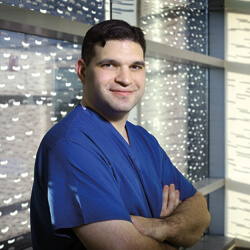
Cardiovascular Report
January 6, 2014

“The room quickly filled with people—they thought I was having a heart attack,” Pena says. He was admitted to the hospital for a range of tests. While it wasn’t a heart attack, an abnormal stress test pointed to coronary artery disease and he was transferred the following morning to The Johns Hopkins Hospital. There, Jeffrey Brinker performed a cardiac catheterization and saw that Pena had three significant blockages in his left main and left anterior descending (LAD) artery.
“I was told that because of the severity of my blockages, I needed bypass surgery,” Pena says. “I was surprised because I had no idea that I had heart disease. I never had chest pain.”
Two days after his symptoms started, with his family at his side, Pena was being prepared for a double cardiac bypass operation. Cardiac surgeon Christopher Sciortino says Pena was fortunate he had the symptoms in a medical setting and was diagnosed quickly.
“His left main artery was 60 percent occluded just above juncture of the circumflex and the LAD, and there were severe secondary blockages in those vessels as well,” says Sciortino, who performed the operation.
Pena made a very fast recovery. He left the hospital five days after surgery and he went back to his busy job within six weeks.
“I heard that walking was the best way to recover, and little by little, I increased the amount and walking every day,” he says. Looking back three months after the surgery, with a very raspy voice, Pena says, “I feel that I have more energy than before the operation and I’m doing great,” adding that he has an appointment next week to finally have the vocal papillomas removed.

